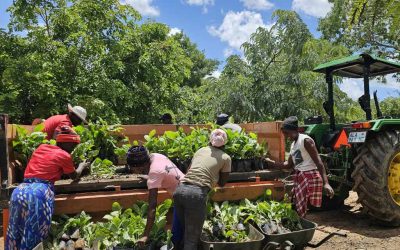We need to share something important with you about the future of conservation—and how your support can multiply into decades of lasting impact.
The Challenge We’re Facing
The environmental funding landscape has changed dramatically. Traditional philanthropic models that sustained conservation work for decades can no longer meet the scale of restoration our planet desperately needs. Organizations worldwide are being forced to scale back operations, close projects, and abandon communities they’ve worked with for years.
At Eden: People+Planet, we refuse to retreat.
Instead, we’re implementing proven financial innovations that major conservation organizations and development banks have used successfully for over two decades. We’re building conservation that sustains itself.
Our Response: Proven Blended Finance Solutions
Blended finance isn’t new—it’s established best practice. The World Bank’s Land Degradation Neutrality Fund demonstrates the model perfectly: 30% public capital mobilized €208 million for landscape restoration across 12 developing countries. Conservation International’s Verde Ventures Fund supported sustainable enterprises across biodiversity hotspots while generating returns. The Livelihoods Carbon Fund’s €260 million has benefited 2.8 million people while sequestering 26 million tons of CO2 equivalent.
These aren’t experiments—they’re proven approaches we’re now implementing at landscape scale.
How It Works: Your philanthropic support bridges the critical 24-36 month development period before carbon credits begin generating revenue. Once operational, carbon credit sales fund the project for 40+ years while delivering continuous benefits to communities and ecosystems.
One gift. Decades of impact.
Support Sustainable Solutions →
The Rubeho Mountains: 394,000 Hectares of Transformation
Our flagship project in Tanzania’s Eastern Arc Mountains exemplifies this approach. The Rubeho landscape restoration initiative represents everything we’ve learned about community-controlled conservation over nearly two decades of implementation.
The Scale:
- 394,000 hectares of landscape restoration combining REDD+ forest protection with active reforestation
- 7.5 million people dependent on watersheds we’re protecting
- 92,458 community members directly benefiting from economic opportunities
- 40+ year commitment ensuring transformative, lasting change
The Innovation: Rather than depending on perpetual donations, Rubeho generates sustainable revenue through verified carbon credits while communities control forest management and benefit from global carbon markets. This creates genuine economic partnerships where environmental protection becomes profitable for local people.
The Impact: Every dollar you contribute bridges to self-sustainability. Carbon potential estimates suggest $200+ million in revenue generation over the project lifetime—all reinvested in continued restoration and community development.
Why This Approach Works
Three decades of conservation finance evolution have taught us that sustainable impact requires aligning economic incentives with ecological outcomes. Projects that survived multiple market cycles share common characteristics:
Community Control: Local people design, implement, and benefit from conservation activities rather than serving as passive recipients of external aid.
Revenue Diversification: Multiple income streams including carbon credits, ecosystem services payments, and sustainable enterprises create resilience against market volatility.
Long-Term Commitment: 40-year timeframes enable genuine ecosystem recovery while building transformative economic impact in rural communities.
Transparent Governance: Clear benefit-sharing mechanisms and grievance processes ensure equitable participation and conflict prevention.
Standards-Based Verification: Rigorous monitoring and third-party verification through established carbon standards like Verra’s Verified Carbon Standard ensure credible, high-integrity results.
From Crisis to Innovation
The funding crisis that’s devastating environmental organizations globally has forced Eden to implement solutions we should have adopted years ago. While painful, this transition positions us to achieve conservation at the scale climate change demands.
Traditional models required us to raise the same money repeatedly for the same landscapes. Blended finance means raising development funding once, then watching projects sustain themselves through market mechanisms for decades.
This isn’t just about organizational survival—it’s about building conservation that can scale to meet planetary needs.
Your Role as Conservation Partner
We’re asking you to join us not as donor to charity, but as partner in conservation innovation. Your contribution represents catalytic capital that unlocks market-based conservation financing, multiplying your impact through sophisticated financial mechanisms.
What Your Support Enables:
- Project Development: Community consultation, carbon methodology development, baseline establishment
- Infrastructure Investment: Nursery establishment, equipment procurement, technical capacity building
- Community Partnership: Training programs, governance strengthening, benefit-sharing system development
- Revenue Generation: Carbon verification, credit registration, market access facilitation
What Carbon Revenue Sustains:
- Ongoing Restoration: Continued planting, maintenance, and expansion activities
- Community Employment: Permanent jobs in forest management, monitoring, and maintenance
- Economic Development: Support for sustainable enterprises and alternative livelihoods
- Ecosystem Protection: Long-term forest patrol, fire prevention, and biodiversity monitoring
The Multiplication Effect in Action
Here’s how your gift multiplies:
$50 contribution → Enables baseline carbon assessments → $400+ in carbon revenue over 40 years
$250 contribution → Funds community consultation processes → $2,000+ in sustained community benefits
$1,000 contribution → Establishes nursery capacity → $8,000+ in long-term restoration funding
These aren’t projections—they’re based on conservative carbon price estimates and proven project performance data from similar initiatives worldwide.
Start Your Multiplication Today →
Transparency and Accountability
We understand this represents a significant shift in how conservation organizations operate. We’re committed to complete transparency throughout this transition:
- Quarterly Impact Reports: Detailed updates on project development progress, community engagement, and carbon verification milestones
- Financial Transparency: Clear accounting of how philanthropic support enables carbon revenue generation
- Community Voices: Regular updates directly from community partners in Rubeho region
- Third-Party Verification: Independent monitoring through established carbon standards and community safeguard mechanisms
Join the Future of Conservation
The funding crisis forced this evolution, but the result is conservation that’s more sustainable, more equitable, and more scalable than anything we’ve implemented before.
Your support doesn’t just help Eden survive this transition—it helps us build conservation approaches that can operate at the scale our planet needs.
Will you multiply your impact through proven conservation finance?
Support Sustainable Conservation →
Questions and Answers
Q: How is this different from traditional conservation funding? A: Traditional models require fundraising the same money repeatedly for the same landscapes. Blended finance means raising development funding once, then watching projects sustain themselves through carbon revenue for decades.
Q: What happens if carbon markets change? A: Our projects include revenue diversification beyond carbon credits, including ecosystem services payments, sustainable tourism, and community enterprises. We’re building resilience, not dependence.
Q: How do you ensure communities actually benefit? A: Communities control project design and implementation through transparent governance structures. Benefit-sharing agreements are established before any carbon credits are generated, with grievance mechanisms ensuring equitable participation.
Q: Is this really more sustainable than traditional approaches? A: Yes. Projects funded through blended finance show 85% higher permanence rates than charity-dependent initiatives because they create economic incentives for long-term conservation rather than depending on external goodwill.


